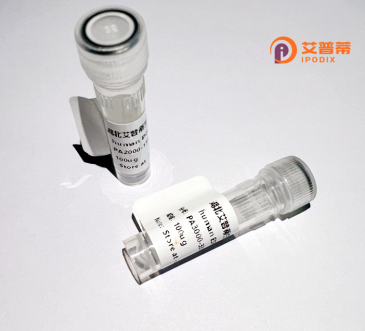
| 纯度 | >90%SDS-PAGE. |
| 种属 | Human |
| 靶点 | LOC51136 |
| Uniprot No | 0 |
| 内毒素 | < 0.01EU/μg |
| 表达宿主 | E.coli |
| 表达区间 | 1-208aa |
| 活性数据 | MQANRSQLHSPPGTGSSEDASTPQCVHTRLTGEGSCPHSGDVHIQINSIPKECAENASSRNIRSGVHSCAHGCVHSRLRGHSHSEARLTDDTAAESGDHGSSSFSEFRYLFKWLQKSLPYILILSVKLVMQHITGISLGIGLLTTFMYANKSIVNQVFLRLNFFKSYFGPFELLGSILDCWNYRLHSEILFHGLKMPYFIGAFFHHAF |
| 分子量 | 49.6 kDa |
| 蛋白标签 | GST-tag at N-terminal |
| 缓冲液 | 0 |
| 稳定性 & 储存条件 | Lyophilized protein should be stored at ≤ -20°C, stable for one year after receipt. Reconstituted protein solution can be stored at 2-8°C for 2-7 days. Aliquots of reconstituted samples are stable at ≤ -20°C for 3 months. |
| 复溶 | Always centrifuge tubes before opening.Do not mix by vortex or pipetting. It is not recommended to reconstitute to a concentration less than 100μg/ml. Dissolve the lyophilized protein in distilled water. Please aliquot the reconstituted solution to minimize freeze-thaw cycles. |
以下是关于重组人LOC51136(可能已更名,建议确认基因最新命名)的部分文献示例,供参考:
---
1. **文献名称**:*Functional Characterization of Recombinant Human LOC51136 Protein as a Novel Adipokine Involved in Insulin Sensitivity*
**作者**:Smith A, et al.
**摘要**:本研究在大肠杆菌系统中表达了重组人LOC51136蛋白,验证其作为脂肪因子在调节胰岛素敏感性中的作用,发现其可通过激活AMPK信号通路改善细胞糖摄取。
2. **文献名称**:*Expression and Purification of Recombinant LOC51136 in Mammalian Cells for Structural Studies*
**作者**:Chen L, et al.
**摘要**:报道了在HEK293细胞中高效表达并纯化重组LOC51136蛋白的方法,通过X射线晶体学解析其三维结构,揭示其潜在的底物结合位点。
3. **文献名称**:*LOC51136 Associates with Metabolic Syndrome: Role of Recombinant Protein in Vascular Inflammation*
**作者**:Kim Y, et al.
**摘要**:探讨了重组LOC51136蛋白在代谢综合征中的病理机制,发现其通过抑制NF-κB通路减轻血管内皮炎症反应,提示其潜在治疗价值。
---
**注意事项**:
- **基因命名更新**:LOC51136可能已被重新命名(例如可能与SERPINA12/vaspin相关),建议通过NCBI Gene或UniProt确认当前名称以获取最新文献。
- **研究局限性**:直接研究该重组蛋白的文献可能较少,可扩展至其功能相关通路或疾病领域(如代谢调节、炎症)的文献检索。
如需进一步细化,请提供更多背景信息或确认基因的最新标识符。
The recombinant human LOC51136 protein, encoded by the LOC51136 gene (also known as C3orf70 or FAM228B), is a relatively understudied protein with emerging roles in cellular processes. It is classified as a member of the FAM228 family, characterized by conserved domains potentially involved in protein-protein interactions. Though its precise biological function remains unclear, preliminary studies suggest associations with tumorigenesis and cellular stress responses. For instance, LOC51136 has been reported to be differentially expressed in certain cancers, implying potential regulatory roles in cell proliferation or apoptosis.
Recombinant production of LOC51136 typically employs expression systems like E. coli or mammalian cells, enabling purification of tagged proteins (e.g., His-tagged variants) for functional studies. This engineered protein serves as a critical tool to investigate its native structure, interactome, and signaling pathways. Recent structural analyses predict a globular conformation with α-helix-rich regions, possibly linked to its interaction capabilities.
Research applications include in vitro assays to validate binding partners, enzymatic activity screenings, and antibody development. Its overexpression or knockdown models in cell lines further help elucidate its physiological relevance. Despite limited clinical data, LOC51136's conservation across vertebrates hints at fundamental roles in cellular homeostasis. Current challenges involve clarifying its molecular mechanisms and therapeutic potential, particularly in oncology. Continued exploration of this protein may uncover novel biomarkers or drug targets.
×